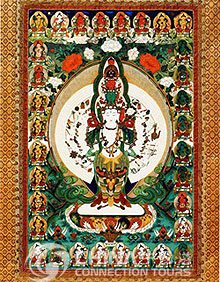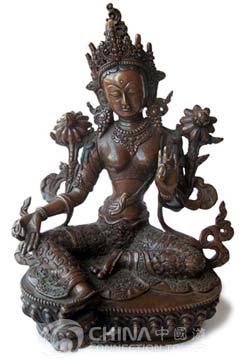
 Thangka
Thangka
Thangkas are traditional Tibetan artworks with painted or embroidered images rendered on cloth, silk or paper and are mounted on a cloth backing. They may be rolled up like a scroll when not hung. The material used for Thangkas is linen cloth, coarse woolen fabric, silk or paper. The cloth needs to be prepared first and then the artist sketches the portraits with charcoal sticks, usually beginning in the center. Color comes last with pigments from non-transparent minerals and plants such as malachite and cinnabar. They are mixed with animal glue and ox bile to maintain the color's luster.
Fresco
Tibetan fresco painting is an important part of Tibetan art. Frescoes include the images of Buddha in his many manifestations, portraits of saints, great masters, founders of various Buddhist sects and the stories of their lives, wars, scenes of manual labor, construction of monasteries and everyday life of the people.
Wooden Tablet Painting
Wooden tablet painting represents yet another branch of Tibetan art. Its subjects and pictorial composition are similar to those of Thangka and the difference is that the pictures are drawn on wooden tablets of various shapes. Some of them have handles for holding and hanging.
Sand Painting
In a sand painting, colored sand and minerals are placed inside a cone with a tiny hole at the tip. The sand will flow out of the whole to form a single line in the picture.
Bronze
 Bronze sculpting is a complicated, difficult and time-consuming process that sometimes many artists spend their wholes without seeing the finished product. Tibetan artists absorbed the influences of Han, Nepalese and Indian sculpture and developed a style and craft of their own that is distinctively Tibetan.
Bronze sculpting is a complicated, difficult and time-consuming process that sometimes many artists spend their wholes without seeing the finished product. Tibetan artists absorbed the influences of Han, Nepalese and Indian sculpture and developed a style and craft of their own that is distinctively Tibetan.
Clay Sculpture
Many clay sculptures of Buddha, saints and great figures exist today, some still with treasures preserved inside.
Clay Modeling
Clay modeling of miniatures represents a form of artistic expression in Tibetan Buddhism. As the process is not difficult and the material is easily obtainable, such art is turned out in large quantities in Tibet.
Wood and Stone Carving
These beautiful engravings lavishly decorate the columns, beams, doors, windows and crossbeam supports in Tibetan monasteries and temples. Shrines, platforms, altars, stupas and some ritual objects are often adorned with wood or stone carving.
Ritual Objects
The ritual objects of Tibetan Buddhism may be divided into six groups symbolizing respect, praise, attendance, devotion, protection and guidance. Kasayas, necklaces and hadas (ceremonious scarves) are symbols of respect. Bells, drums, bone flutes, and six-string lutes symbolize praise. The Buddha's throne, water vessels, flower baskets, and canopies belong to the attendance group. Rosary beads, the fish-shaped wooden percussion instrument, scepters, bells, and initiation vessels are used to show devotion. Images of protective deities and secret messages signify protection. Wheels, cylinders, tablets, banners and stones with the "Six-Syllable True Teaching" on them symbolize guidance.
Butter Sculpture
Most butter sculptures produced in Lhasa and elsewhere are made for the Lamp Festival on the fifteenth day of the first month of the Tibetan year. The butter is first mixed with ice water, and then mineral dyes are mixed in.
Masks
Masks depict the range of beings from deities to men and animals, religious dances and folk tales. Those depicting humans are carved to display a certain characteristic such as honesty, harshness, greed or humor. Animals on masks are mainly deer, yaks, sheep and birds.

